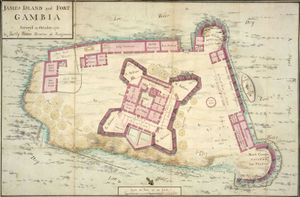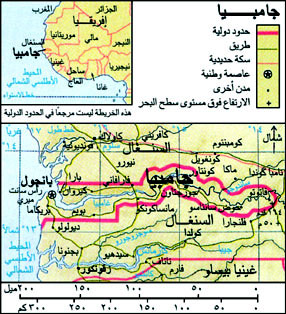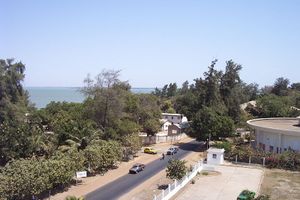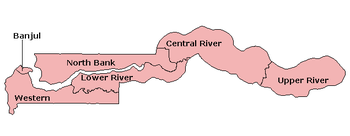گامبيا
جمهورية الگامبيا The Gambia | |||||||||
|---|---|---|---|---|---|---|---|---|---|
الشعار الحادي: "Progress, Peace, and Prosperity" | |||||||||
النشيد: "For the Gambia, Our Homeland" | |||||||||
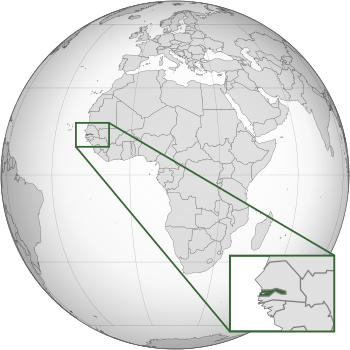 Location of the Gambia (dark green) in western Africa | |||||||||
| العاصمة و largest metropolitan area | بانجول 13°28′N 16°36′W / 13.467°N 16.600°W | ||||||||
| اللغات الرسمية | English | ||||||||
| National languages | |||||||||
| الجماعات العرقية (تعداد 2013) | |||||||||
| صفة المواطن | Gambian | ||||||||
| الحكومة | Unitary presidential republic | ||||||||
| Adama Barrow | |||||||||
| Isatou Touray | |||||||||
| التشريع | National Assembly | ||||||||
| Independence | |||||||||
• from the United Kingdom | 18 February 1965 | ||||||||
• dissolution of the Senegambia Confederation | 30 September 1989 | ||||||||
| المساحة | |||||||||
• الإجمالية | 10،689 km2 (4،127 sq mi) (159th) | ||||||||
• الماء (%) | 11.5 | ||||||||
| التعداد | |||||||||
• تقدير 2020 | 2,173,999 (144th) | ||||||||
• إحصاء 2013 | 1,857,181[1] | ||||||||
• الكثافة | 176.1/km2 (456.1/sq mi) (74th) | ||||||||
| ن.م.إ. (ق.ش.م.) | تقدير 2020 | ||||||||
• الإجمالي | $5.420 billion[2] | ||||||||
• للفرد | $2,240[2] | ||||||||
| ن.م.إ. (الإسمي) | تقدير 2020 | ||||||||
• الإجمالي | $1.810 billion[2] | ||||||||
• للفرد | $746[2] | ||||||||
| جيني (2015) | ▼ 35.9[3] medium | ||||||||
| م.ت.ب. (2019) | ▲ 0.496[4] low · 172nd | ||||||||
| العملة | Dalasi (GMD) | ||||||||
| التوقيت | UTC (GMT) | ||||||||
| Daylight saving time is not observed | |||||||||
| جانب السواقة | right | ||||||||
| مفتاح الهاتف | +220 | ||||||||
| كود آيزو 3166 | GM | ||||||||
| النطاق العلوي للإنترنت | .gm | ||||||||
| |||||||||
جامبيا أو غامبيا أو الگامبيا ، جمهورية الگامبيا ، بالإنجليزية Gambia ، تعرف أيضاً بگامبيا ، وهى من دول الغرب الأفريقي. وهى أصغر دولة في الأرض الرئيسية لقارة أفريقيا.[أ] ويحدها من الشمال والشرق والجنوب السنغال،[5] It is situated on both sides of the lower reaches of the Gambia River, which flows through the centre of the country and empties into the Atlantic Ocean. The national namesake river demarcates the elongated shape of the country, which has an area of 11،300 متر كيلومربع (4،400 sq mi) and a population of 2,468,569 people in 2024.[6] The capital city is Banjul, which has the most extensive metropolitan area in the country;[7] the second- and third-largest cities are Serekunda and Brikama.[8]
Arab Muslim merchants traded with native West Africans in Gambia throughout the 9th and 10th centuries. In 1455, the Portuguese were the first Europeans to enter Gambia, although they never established significant trade there.[9] The region was made a part of the British Empire by establishment of a colony in 1765,[10] and exactly 200 years later, in 1965, The Gambia gained independence under the leadership of Dawda Jawara. Jawara ruled until Yahya Jammeh seized power in a bloodless 1994 coup, with Jammeh ruling until 2017. Adama Barrow became The Gambia's third president in January 2017, after defeating Jammeh in the December 2016 elections.[11] Jammeh initially accepted the results, but then refused to leave office, triggering a constitutional crisis and military intervention by the Economic Community of West African States that resulted in his removal two days after his term was initially scheduled to end.[12][13][14]
The Gambia has been a member of the Economic Community of West African States since its conception in 1975 and is a member of the Commonwealth,[15] with English being the country's sole official language, both legacies of its British colonial past. The Gambia's economy is dominated by farming, fishing, and especially tourism. In 2015, 48.6% of the population lived in poverty.[16] In rural areas, poverty was even more widespread, at almost 70%.[16]
أصل الاسم
The name "Gambia" is derived from the Mandinka term Kambra/Kambaa, meaning Gambia River (or possibly from the sacred Serer Gamba,[17] a special type of calabash beaten when a Serer elder dies).[18] Upon independence in 1965, the country used the name The Gambia. Following the proclamation of a republic in 1970, the long-form name of the country became Republic of The Gambia.[19] The administration of Yahya Jammeh changed the long-form name to Islamic Republic of The Gambia in December 2015.[20] On 29 January 2017 President Adama Barrow changed the name back to Republic of The Gambia.[21][22]
The Gambia is one of a small number of countries for which the definite article is commonly (although far from universally) used in its English-language name and where the name is not either plural or descriptive (e.g. "the Philippines" or "the United Kingdom").[23] The article is also officially used by the country's government and by international bodies. The article was originally used because the region was named after "The Gambia [River]". In 1964, shortly prior to the country's independence, the Prime Minister Dawda Jawara wrote to the Permanent Committee on Geographical Names for British Official Use requesting that the name The Gambia retain the definite article, in part to reduce confusion with Zambia which had also recently become independent.[24] In the 20th and 21st centuries, both Gambia and The Gambia were and are in common use.
التاريخ
9th–16th centuries: Muslim and Portuguese influence
Arab traders provided the first written accounts of The Gambia area in the ninth and tenth centuries. During the tenth century, Muslim merchants and scholars established communities in several West African commercial centres. Both groups established trans-Saharan trade routes, leading to a large export trade of local people as slaves,[بحاجة لمصدر] along with gold and ivory, as well as imports of manufactured goods.
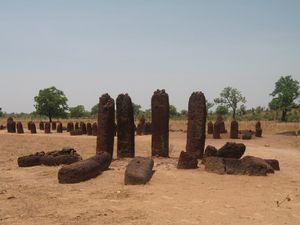
By the 11th or 12th century, the rulers of kingdoms such as Takrur (a monarchy centred on the Senegal River just to the north), ancient Ghana and Gao had converted to Islam and had appointed to their courts Muslims who were literate in the Arabic language.[25] At the beginning of the 14th century, most of what is today called The Gambia was part of the Mali Empire. The Portuguese reached this area by sea in the mid-15th century and began to dominate overseas trade.
English and French administration
بدأ التاريخ الحديث لغامبيا مع وصول الأوربيين إليها في منتصف القرن الخامس عشر الميلادي، فقد وصل إليها المستكشفون البرتغاليون عام 1455م، وأسسوا فيها محطات تجارية على طول نهر غامبيا، وفي القرن السابع عشر الميلادي طردت الشركات الفرنسية والبريطانية البرتغاليين من غامبيا، وفي عام 1816 اشترت بريطانيا جزيرة بانجول الصغيرة من أحد الحكام المحليين وأسست بها مدينة باترست (بانجول حالياً)، وعلى الرغم من مقاومة السكان المحليين استطاعت بريطانيا أن تتوسع باتجاه الداخل، ووصلت إلى الأجزاء العليا من نهر غامبيا، وفي عام1889 اتفقت بريطانيا وفرنسا فوضعتا الحدود الحالية لغامبيا ضمن دولة السنغال، وفي عام 1894 أصبحت محمية بريطانية بعد معارضة من فرنسا، وفي الأعوام التالية حكم البريطانيون في غامبيا من خلال الحكام المحليين.
In 1588, the claimant to the Portuguese throne, António, Prior of Crato, sold exclusive trade rights on the Gambia River to English merchants. Letters patent from Queen Elizabeth I confirmed the grant. In 1618, King James I of England granted a charter to an English company for trade with The Gambia and the Gold Coast (now Ghana). Between 1651 and 1661, some parts of The Gambia – St. Andrew's Island in the Gambia River, including Fort Jakob, and St. Mary Island (modern day Banjul) and Fort Jillifree – came under the rule of the Duchy of Courland and Semigallia, a vassal state of Polish-Lithuanian Commonwealth in what is now Latvia, having been bought by Prince Jacob Kettler.[26] The colonies were formally ceded to England in 1664.
During the late 17th century and throughout the 18th century, the British Empire and the French Empire struggled continually for political and commercial supremacy in the regions of the Senegal River and the Gambia River. The British Empire occupied The Gambia when an expedition led by Augustus Keppel landed there following the capture of Senegal in 1758. The 1783 Treaty of Versailles gave Great Britain possession of the Gambia River, but the French retained a tiny enclave at Albreda on the river's north bank. This was finally ceded to the United Kingdom in 1856.
Slavery (17th–19th centuries)
As many as three million people may have been taken as slaves from this general region during the three centuries that the transatlantic slave trade operated. It is not known how many people were taken as slaves by intertribal wars before the transatlantic slave trade began. Most of those taken were sold by other Africans to Europeans: some were prisoners of intertribal wars; some were victims sold because of unpaid debts, and many others were simply victims of kidnapping.[27]
Traders initially sent people to Europe to work as servants until the market for labour expanded in the West Indies and North America in the 18th century. In 1807, the United Kingdom abolished the slave trade throughout its empire. It also tried, unsuccessfully, to end the slave trade in The Gambia. Slave ships intercepted by the Royal Navy's West Africa Squadron in the Atlantic were also returned to The Gambia, with people who had been slaves released on MacCarthy Island far up The Gambia River where they were expected to establish new lives.[28] The British established the military post of Bathurst (now Banjul) in 1816.
Gambia Colony and Protectorate (1821–1965)
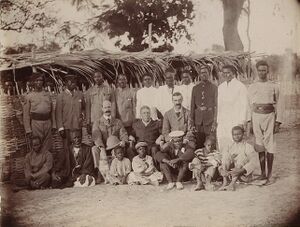
In the ensuing years, Banjul was at times under the jurisdiction of the British Governor-General in Sierra Leone. In 1888, The Gambia became a separate colony.[29]
An agreement between the Britian and the France in 1889 established the boundaries of the colony. In 1891, a joint Anglo-French Boundary Commission faced resistance from local leaders whose lands would be divided.[30] The Gambia became a British Crown colony called British Gambia, divided for administrative purposes into the colony (city of Banjul and the surrounding area) and the protectorate (remainder of the territory). The Gambia received its own executive and legislative councils in 1901, and it gradually progressed toward self-government. Slavery was abolished in 1906[31] and following a brief conflict between the British colonial forces and indigenous Gambians, British colonial authority was firmly established.[32] In 1919, an inter-racial relationship between Travelling Commissioner J. K. McCallum and Wolof woman Fatou Khan scandalized the administration.[33]
During World War II, some soldiers fought with the Allies of World War II. Though these soldiers fought mostly in Burma, some died closer to home and a Commonwealth War Graves Commission cemetery is in Fajara (close to Banjul). Banjul contained an airstrip for the US Army Air Forces and a port of call for Allied naval convoys.[34]
After World War II, the pace of constitutional reform increased. Following general elections in 1962, the United Kingdom granted full internal self-governance in the following year.[34]
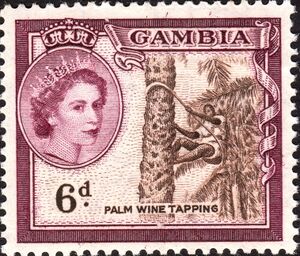
ظلت غامبيا خاضعة للإدارة البريطانية المباشرة حتى عام 1945 بعد الحرب العالمية الثانية بدأ سكانها يسعون وراء اهتماماتهم الإفريقية، وتساهلت بريطانيا في إدارتها للبلاد بعد اتضاح الشخصية الإفريقية لمثقفي گامبيا، وأخذت غامبيا ترقى في سلم الحضارة، واهتم المواطنون بالتعليم، وقد شجعت بريطانيا ذلك من أجل إعداد وتدريب كوادر إدارية لإدارة البلاد، فارتفعت أعداد المدارس الابتدائية من ست مدارس في عام 1940 إلى 37 مدرسة في عام 1960، وتطورت العناية الصحية بزيادة أعداد المراكز الصحية وأعداد الأطباء. الأحزاب السّياسيّة الأولى البادئة في 1950، بتقليل قوّة الرّؤساء في صالح المواطن العاديّ كهدف رئيسيّ.
استقلت جامبيا في 18 شباط 1965 وأصبحت عضواً في رابطة الشعوب البريطانية (الكومنولث)، وأصبح داودا كايرابا جاوارا Dawda Kairaba Jawara الذي كان ممثلاً لسلطات الحماية البريطانية رئيساً لمجلس الوزراء.
أُجري استفتاء شعبي عام 1970 فأصبحت جامبيا بموجبه جمهورية برئاسة جوارا، وفي عام 1981 جرت محاولة انقلابية فاشلة نتج عنها قيام اتحاد بين السنغال وگامبيا، بإسم "سنگامبيا"، عام 1982. فأصبح الرئيس السنغالي عبدو ضيوف رئيساً لدولة الاتحاد وجوارا نائباً للرئيس. وفي عام 1989 انهار الاتحاد مع السنغال وعاد جوارا مرة ثانية رئيساً للبلاد. في عام 1991 الدّولتان وقّعتا صداقةً ومعاهدة تعاون.
وفي عام 1994 أُسقط الجيش بانقلاب أبيض حكومة جاوارا، وفي عام 1996 تم التصديق على دستور جديد للبلاد أُعلن فيه الحكم المدني في البلاد، يُنتخب بموجبه الرئيس مدة خمس سنوات، وقد نفذ هذا الدستور في شهر كانون الثاني/يناير 1997.
وانتخابات الرّئاسة جديدة, اتّبع بالاقتراع البرلمانيّ في عام 1997, قد أكمل عودةً صوريّةً إلى الحكم المدنيّ . ظهرت جامبيا من عزلتها حديثًا لقبول مقعد غير دائم على مجلس أمن الأمم المتّحدة أثناء 1998-99.
Post-independence (1965–present)
Monarchy and republican democracy
The Gambia achieved independence on 18 February 1965, as a constitutional monarchy within the Commonwealth, with Elizabeth II as Queen of The Gambia, represented by the Governor-General. Shortly thereafter, the national government held a referendum proposing that the country become a republic. This referendum failed to receive the two-thirds majority required to amend the constitution, but the results won widespread attention abroad as testimony to The Gambia's observance of secret balloting, honest elections, civil rights, and liberties.[34]
On 24 April 1970, The Gambia became a republic within the Commonwealth, following a second referendum. Prime Minister Sir Dawda Kairaba Jawara assumed the office of president, an executive post, combining the offices of head of state and head of government which he held since 1962.[35] President Sir Dawda Jawara was re-elected five times.[36]
1981 attempted coup
An attempted coup on 29 July 1981 followed a weakening of the economy and allegations of corruption against leading politicians.[36] The coup attempt occurred while President Jawara was visiting London and was carried out by the leftist National Revolutionary Council, composed of Kukoi Samba Sanyang's Socialist and Revolutionary Labour Party (SRLP) and elements of the Field Force, a paramilitary force which constituted the bulk of the country's armed forces.[36]
President Jawara requested military aid from Senegal, which deployed 400 troops to The Gambia on 31 July. By 6 August, some 2,700 Senegalese troops had been deployed, defeating the rebel force.[36] Between 500 and 800 people were killed during the coup and the ensuing violence.[36] In 1982, in the aftermath of the 1981 attempted coup, Senegal and The Gambia signed a treaty of confederation. The Senegambia Confederation aimed to combine the armed forces of the two states and to unify their economies and currencies. After just seven years, The Gambia permanently withdrew from the confederation in 1989.
1994 Yahya Jammeh coup; return to electoral democracy
In 1994, the Armed Forces Provisional Ruling Council (AFPRC) deposed the Jawara government and banned opposition political activity. Lieutenant Yahya Jammeh, chairman of the AFPRC, became head of state. Jammeh was just 29 years old at the time of the coup. The AFPRC announced a transition plan to return to a democratic civilian government. The Provisional Independent Electoral Commission (PIEC) was established in 1996 to conduct national elections and transformed into the Independent Electoral Commission (IEC) in 1997 and became responsible for the registration of voters and for the conduct of elections and referendums.
In late 2001 and early 2002, The Gambia completed a full cycle of presidential, legislative, and local elections, which foreign observers deemed free, fair, and transparent.[37] President Yahya Jammeh, who was elected to continue in the position he had assumed during the coup, took the oath of office again on 21 December 2001. Jammeh's Alliance for Patriotic Reorientation and Construction (APRC) maintained its strong majority in the National Assembly, particularly after the main opposition United Democratic Party (UDP) boycotted the legislative elections.[38]
On 2 October 2013, The Gambian interior minister announced that The Gambia would leave the Commonwealth with immediate effect, ending 48 years of membership of the organisation. The Gambian government said it had "decided that The Gambia will never be a member of any neo-colonial institution and will never be a party to any institution that represents an extension of colonialism".[39]
On 11 December 2015, President Jammeh declared The Gambia an Islamic republic, calling it a break from the country's colonial past.[40]
Incumbent President Jammeh faced opposition leaders Adama Barrow from the Independent Coalition of parties[41] and Mamma Kandeh from The Gambia Democratic Congress party[42] in the December 2016 presidential elections. The Gambia sentenced main opposition leader and human rights advocate Ousainou Darboe to 3 years in prison in July 2016,[43] disqualifying him from running in the presidential election.
2016 Jammeh defeat in elections
Following the 1 December 2016 elections, the elections commission declared Adama Barrow the winner of the presidential election.[44] Jammeh, who had ruled for 22 years, first announced he would step down after losing the 2016 election before declaring the results void and calling for a new vote, sparking a constitutional crisis and leading to an invasion by an ECOWAS coalition.[45] On 20 January 2017, Jammeh announced that he had agreed to step down and would leave the country.[13]
Since 2017
In January 2017, President Barrow removed the "Islamic" title from The Gambia's name.[21]
On 14 February 2017, The Gambia began the process of returning to its membership of the Commonwealth and formally presented its application to re-join to Secretary-General Patricia Scotland on 22 January 2018.[46][47] Boris Johnson, who became the first British foreign secretary to visit The Gambia since the country gained independence in 1965,[48] announced that the British government welcomed The Gambia's return to the Commonwealth.[48] The Gambia officially rejoined the Commonwealth on 8 February 2018.[49][50]
On 28 February 2018, Jaha Dukureh, a women's rights activist was nominated for the Nobel Peace Prize for her work in combating female genital mutilation.[51]
On 4 December 2021, Adama Barrow won re-election in the presidential election.[52]
On 20 December 2022, a supposed coup attempt by The Gambian army was foiled,[53] with four soldiers arrested. The Gambia Armed Forces have denied that any attempt at a coup was made.[53]
الجغرافيا
تقع گامبيا على ساحل المحيط الأطلنطي في الطرف الغربي من قارة إفريقيا ، وتحيط بها من جميع الجهات ما عدا الغرب دولة السنغال، حيث إن غامبيا عبارة عن شريط ضيق من الأرض على امتداد نهر غامبيا الأدنى والذي يجري مسافة 322 كيلو متر ليصب في المحيط الأطلنطي. كما أن غامبيا تعد أصغر دولة في القارة الإفريقية، ذات المناخ الاستوائي الحار. يبدأ موسم الأمطار فيها من يونيو إلى نوفمبر، ويأخذ المناخ في البرودة والجفاف من شهر نوفمبر إلى مايو.
تُنْسَبُ گامبيا إلى نهر گامبيا الذي يشقها من الشرق إلى الغرب، وهي بلد صغير يقع في منطقة السافانا غرب إفريقيا، تحده السنغال من جميع الجهات باستثناء الساحل الغربي الذي يطل على المحيط الأطلنطي. ويعد نهر غامبيا أهم المعالم الطبيعية في البلاد ومورد أساسي للري وصيد الأسماك إلى جانب أهميته في مجال النقل. وتنتشر المستنقعات في المنطقة الساحلية وعلى ضفاف النهر الذي تكسو الغابات الاستوائية ضفاف مجراه الأسفل. أما المناطق الأخرى فهي مغطاة بالأشجار والأعشاب. يسود البلاد مناخ شبه مداري ينقسم إلى فصلين متباينين أحدهما جاف والآخر ممطر.
تمتد أراضي غامبيا Gambia في وادي نهر غامبيا، أكثر الأنهار الإفريقية استعمالاً في الملاحة، ويبلغ أقصى اتساع للدولة زهاء 50كم على ضفتي المجرى الأدنى للنهر، بينما يراوح عرض الدولة على ضفتي النهر في معظم المواقع نحو 25كم، وتصلح مياه النهر للزوارق البحرية ذات الغاطس 19قدماً أو أقل، وهذه تعبر النهر حتى مسافة 150كم، وتستطيع الزوارق الأصغر الوصول إلى جورجتاون التي تبعد قرابة 250كم عن ساحل المحيط، وتصل الزوارق النهرية التي تسمى «فاتوتو» الى مسافة 500كم باتجاه الداخل بعيداً عن الساحل.
تتمتع غامبيا بمناخ شبه استوائي يمتد فيه فصل الشتاء البارد من شهر تشرين الثاني/نوفمبر إلى شهر أيار/مايو، وتهب فيه رياح جافة (الهرمطان) قادمة من الصحراء، تثير الغبار والأتربة في الجو. متوسط درجات الحرارة في الشتاء ـ وهو الفصل الجاف ـ 16درجة مئوية، ويمتد فصل الصيف الماطر من شهر حزيران/يونيو إلى شهر تشرين الأول/أكتوبر. ويراوح معدل الأمطار السنوية بين 650 ـ 1300 مليمتر.
يعد نهر غامبيا المورد الطبيعي الوحيد في البلاد، وتقوم على ضفتيه قرى قليلة متباعدة بعيدة عن المستنقعات التي يتركها النهر على ضفافه، والتربة الزراعية رملية فقيرة تصلح لزراعة الفول السوداني، بينما تُستخدم الأراضي المستنقعية في زراعة الأرز، وتنمو الأعشاب في الأراضي اللحقية المنخفضة، وتنتهي هذه الأراضي بحواف الوادي العلوية المؤلفة من الحجر الرملي الثلاثي الذي تنمو عليه الأشجار الطبيعية، وتتناوب الغابة التي تنمو فيها أشجار الماهوغني مع الأراضي الزراعية التي تعاني من مشكلة التملح، مما دعا إلى قطع أشجار الغابة بهدف استصلاحها واستغلالها في الزراعة، فقضي بذلك على نحو 90% من الغابة الطبيعة، وانعكس ذلك على الحياة البرية مباشرة. تتمثل الحيوانات البرية التي تعيش في غامبيا بالنمور والخنزير البري والتمساح وفرس النهر، وأنواع عدة من الظباء وأنواع كثيرة من الطيور.
التضاريس
لاتختلف تضاريس گامبيا كثيرا عن السنغال ، إلا إنها تعد بالاجمال عبارة عن سهل طويل يمتد على ضفتي النهر ، والمناخ مداري حار لا يلطف من قسوته إلا البحر والنهر..
نظام الحكم
گامبيا بلد جمهوري عضو في منظمة المؤتمر الإسلامي واتحاد الكومنولث. أقرت جامبيا دستورًا جديدًا عام 1996م. يحكم البلاد، بمقتضى الدستور، رئيس ينتخبه الشعب لفترة خمس سنوات. يعين الرئيس مجلسًا للوزراء لتصريف شؤون المهام الحكومية اليومية. تقوم الجمعية الوطنية (البرلمان) بتشريع قوانين البلاد. ينتخب الشعب 45 عضوًا للبرلمان لفترة خمس سنوات. ويعين الرئيس 4 أعضاء بالبرلمان بالإضافة إلى من ينتخبهم الشعب.
السياسة
الأقسام الادارية
الاقتصاد
يعتمد اقتصاد گامبيا في الغالب على زراعة وتصدير الفول السوداني سواء كحبوب أو زيت أو علف للماشية. وتعتبر الحراجة وصيد الأسماك من أهم القطاعات الفرعية التي توفر فرص الاستخدام لغالبية السكان. كما يوجد نشاط صغير الحجم في مجال الصناعات التحويلية يتمثل في تجهيز الفول السوداني والأسماك والجلود إلى جانب نشاطات أخرى مثل السياحة واستخراج الزيت. وقد شهدت الأعوام الأخيرة إقامة استثمارات في مجال تربية الأربيان والدواجن. ومن بين السلع المصنعة الأخرى التي تسهم في النشاط الاقتصادي: الأحذية، الإسمنت، الآجر، المنتجات المعدنية، الصابون، والمنتجات البلاستيكية
تفتقر غامبيا إلى موارد الثروة المعدنية بجميع أشكالها، لذلك يعد القطاع الزراعي العمود الفقري للاقتصاد الغامبي، إذ يسهم القطاع الزراعي بنحو 33% من مجمل الناتج المحلي، ويشكل الفول السوداني المحصول الرئيسي بين المحاصيل الزراعية التي تسهم كثيراً في الدخل القومي، وقد بلغ إنتاجه 126 ألف طن عام 2000، ونسبته ثلاثة أرباع الصادرات.
يعمل نحو 75% من القوة العاملة في غامبيا في الزراعة، ويأتي في مقدمة المحاصيل الزراعية إلى جانب الفول السوداني، كلٌ من الأرز والقطن والذرة البيضاء والدخن، إضافة إلى تربية الحيوانات من أبقار وأغنام وماعز وتربية الدواجن. وفي سنوات التسعينيات من القرن العشرين اهتمت الدولة بزيادة مساحة محاصيل القطن والسيزال والتبغ والحمضيات لتنويع الإنتاج الزراعي، ويعمل سكان القرى الساحلية في صيد الأسماك، وقد وصل الإنتاج إلى 32.5 ألف طن في معظمه من الأسماك البحرية.
مازالت الصناعة في غامبيا في مراحلها الأولى، يعمل بها أقل من 10% من مجموع القوة العاملة، وتسهم بـ 13% فقط في الناتج المحلي الإجمالي، وتشمل صناعة استخراج زيت النخيل ويزيد الإنتاج على ألفي طن سنوياً إضافة إلى معالجة الفول السوداني وصناعة حفظ الأسماك وبناء سفن الصيد الصغيرة وصناعة المشروبات والألبسة والأحذية، إلى جانب ذلك أخذ النشاط السياحي يتطور ببطء في البلاد، ووصل عدد السياح الذين زاروا البلاد في عام 1999 زهاء 93 ألف سائح.
تؤدي التجارة والخدمات دوراً مهماً في اقتصاد غامبيا، حيث يعمل بها نحو 15% من مجموع القوة العاملة، ولكنها تقدم نحو 54% من الناتج المحلي الإجمالي.
تستورد غامبيا معظم حاجاتها الصناعية من مواد غذائية ومعادن وزيوت معدنية ومواد كيميائية ومنسوجات ووسائط النقل وأدوات كهربائية وغيرها من السلع، وقد بلغت قيمة الواردات 271 مليون دولار أمريكي عام 2003، وتأتي المستوردات أساساً من الصين 22.3%، السنغال 9.2%، المملكة المتحدة 6.7%، البرازيل 5.9%، هولندا 5.4%، الهند 5%، بلجيكا 4.7%، ألمانيا 4%.
تتمثل الصادرات بمنتجات الفول السوداني والأسماك والمنسوجات القطنية، ويُعاد تصدير بعض السلع المستوردة عن طريق الميناء إلى بقية الدول الإفريقية، وقد بلغت قيمة الصادرات نحو 156 مليون دولار. تذهب هذه الصادرات إلى فرنسا 22.2%، المملكة المتحدة 18.5%، إيطاليا 11.1%، ماليزيا 11.1%، بلجيكا 7.4%، ألمانيا 7.4%.
السكان
معظم السكان في گامبيا من الإفريقيين السود، أما الفئات العرقية الرئيسية الخمس فهي حسب تعداد أفرادها على النحو التالي: جماعة الماندينجو وجماعة الفولاني، وجماعة الولوف وجماعة سيرا هيولي وأخيرًا الجولا. ومعظم سكان جامبيا من المسلمين. يعيش في كافة أرجاء گامبيا نحو 275,000 من جماعة الماندينجو. ويكسبون رزقهم من زراعة الفول السوداني وتجارته. يعيش معظم جماعة الفولا والبالغ عددهم 100,000 نسمة في المناطق الشرقية من جامبيا، ويعملون في تربية الماشية، ويكسبون معيشتهم منها، ومعظمهم من البدو الرحشل ينتقلون بماشيتهم من مكان إلى آخر.
أما جماعة الولوف والبالغ عددهم 90,000 نسمة فمعظمهم يعمل في الزراعة، ويعيشون بالقرب من حدود گامبيا الشمالية أو ينتمون إلى سكان البانجول حيث يشكلون أغلبية السكان هناك. وتستمتع جماعة الولوف بالرقص والموسيقى، وترتدي نساؤهم الملابس الأنيقة والعمامات والفساتين الطويلة ذات الخصر المرتفع، ويتزينَّ بالذهب والمجوهرات.
يعيش معظم جماعة أفراد سيراهيولي والبالغ عددهم 60,000 نسمة في المناطق الشرقية من جامبيا حيث الأراضي غير خصبة والفلاحة فيها أمر عسير. ويأتي كل عام أناس من السنغال يطلق عليهم اسم المزارعين الغرباء لمساعدة رجال سيراهيولي في أعمال الزراعة وحصاد المحاصيل. ويحصلون مقابل ذلك على حصص متفق عليها من المحصول، كما تقدم لهم قطعة من الأراضي يزرعون فيها محاصيلهم.
أما جماعة الجولا التي يبلغ عددها 55,000 نسمة فتعيش في جنوبي نهر جامبيا بالقرب من الساحل. عاشت هذه المجموعة في جامبيا لفترات أطول مما عاشته المجموعات العرقية الأخرى، وكانوا في مرحلة من المراحل من أشد أعداء الماندينجو. ورجال الجولا مزارعون أشداء يعيشون في قرى صغيرة محاطة بجدران مبنية من التراب، ويزرعون الأرز، ويعتمدون عليه غذاء لهم.
يذهب معظم الأطفال الذين يعيشون في بانجول أو المناطق القريبة منها إلى المدارس. في حين يذهب ثلث الأطفال الذين يعيشون في مناطق أخرى من گامبيا إلى المدارس. ويكمل معظم أطفال المدارس مقرر المدارس الإعدادية الذي يستمر لمدة ست سنوات، لكن عدداً قليلاً جدًا منهم يكملون الدراسة في المدارس الثانوية. وتوجد في بانجول مدرسة فنية، كما توجد كلية لتدريب المدرسين في مدينة يوندوم.
تعد غامبيا من أقل البلدان الإفريقية سكاناً فقد وصل عدد سكانها إلى مليون ونصف نسمة تقريباً عام 2004 وتصل الكثافة العامة للسكان إلى 125نسمة/كم2، ويبلغ معدل الزيادة الطبيعية نحو 2.98% سنوياً. يشكل السكان بعمر (0ـ 14سنة) نحو 7.44% من السكان، و(15ـ 64سنة) نحو 52.6% وأكثر من 65 سنة نحو 2.7%، وعلى الرغم من تميز المجتمع الغامبي بالفتوة إلا أنه ينخفض فيه معدل العمر المتوقع عند الولادة إلى 54.79 سنة، ترتفع هذه النسبة إلى 56.87سنة عند الإناث، وتنخفض إلى 52.76 عند الذكور.
اللغة الإنكليزية هي اللغة الرسمية في البلاد، ولكل مجموعة عرقية لغتها الخاصة بها، ويدين نحو 90% من السكان بالإسلام، فيما يعتنق 9% فقط المسيحية، والباقي يعتنقون الديانات المحلية الوثنية.
التعليم
ليس التعليم الأساسي في غامبيا إجبارياً، مع أنه مجاني، وقد تجاوز عدد المسجلين في المدارس الابتدائية 125ألف تلميذ وهم يكوَّنون 78% ممن هم في سن الدراسة، بينما وصل عدد المسجلين في التعليم الثانوي نحو 35 ألف تلميذ، وهم يشكلون فقط 25% ممن هم في سن التعليم الثانوي، أما مؤسسات التعليم العالي فتتمثل بجامعة غامبيا وعدد من المدارس التقنية، وترتفع نسبة الأمية بين البالغين لتصل إلى 60%، فيما ترتفع أكثر من ذلك بين الإناث البالغات، وقد انعكس ذلك على الأوضاع الصحية في البلاد حيث ترتفع نسبة الإصابة بفيروس فقدان المناعة (الإيدز) إلى 1.6% من السكان، فقد قدر عدد المصابين به من البالغين بـ 8400 شخص.
الدين
 مقالة مفصلة: الإسلام في گامبيا
مقالة مفصلة: الإسلام في گامبيا
الهامش
- ^ أ ب National Population Commission Secretariat (30 أبريل 2005). "2013 Population and Housing Census: Spatial Distribution" (PDF). Gambia Bureau of Statistics. The Republic of The Gambia. Archived (PDF) from the original on 3 يناير 2018. Retrieved 29 ديسمبر 2017.
- ^ أ ب ت ث "The Gambia". International Monetary Fund. Retrieved 2021-07-16.
- ^ "GINI index (World Bank estimate) - Data". data.worldbank.org. Archived from the original on 21 أبريل 2018. Retrieved 21 أبريل 2018.
- ^ Human Development Report 2020 The Next Frontier: Human Development and the Anthropocene (PDF). United Nations Development Programme. 15 December 2020. pp. 343–346. ISBN 978-92-1-126442-5. Retrieved 16 December 2020.
- ^ Hoare, Ben. (2002) The Kingfisher A–Z Encyclopedia, Kingfisher Publications. p. 11. ISBN 0-7534-5569-2.
- ^ خطأ استشهاد: وسم
<ref>غير صحيح؛ لا نص تم توفيره للمراجع المسماةCIApop - ^ "Banjul | national capital, The Gambia". Encyclopædia Britannica. Retrieved 7 April 2020.
- ^ "Population of Cities in Gambia 2023". World Population Review.
- ^ Hughes, Arnold; Perfect, David (2008). Historical Dictionary of The Gambia. United States: Scarecrow Press. pp. xxxii f. ISBN 9780810862609.
- ^ Hughes, Arnold (2008) Historical Dictionary of the Gambia. Scarecrow Press. p. xx. ISBN 0810862603.
- ^ Wiseman, John A. (2004). "The Gambia: Recent History". Africa South of the Sahara 2004 (33rd ed.). Europa. p. 456. ISBN 9781857431834.
- ^ Maclean, Ruth (21 يناير 2017). "Yahya Jammeh leaves the Gambia after 22 years of rule". The Guardian (in الإنجليزية البريطانية). ISSN 0261-3077. Archived from the original on 16 مايو 2017. Retrieved 17 مايو 2017.
- ^ أ ب "Gambia's Yayah Jammeh confirms he will step down". Al Jazeera. 20 يناير 2017. Archived from the original on 21 يناير 2017. Retrieved 21 يناير 2017.
- ^ Ramsay, Stuart (22 يناير 2017). "Former Gambia leader Yahya Jammeh flies into political exile" (in الإنجليزية). Sky News. Archived from the original on 12 أغسطس 2022. Retrieved 23 يناير 2017.
- ^ "The Gambia rejoins the Commonwealth".
- ^ أ ب "The Gambia overview". World Bank. Archived from the original on 5 يوليو 2018. Retrieved 5 يوليو 2018.
- ^ Allen Meagher, Andrew Samuel, Baba Ceesay, National Council for the Arts and Culture (Gambia), Historic Sites of The Gambia: Ada Dinkiralu (Mandinka), Bereb-I-Chosan (Wolof), Tarica Tawal (Fula), Nannin (Jola), Soninke Ada (Serehuli), I-Mofan Chosan (Serer): an Official Guide to the Monuments and Sites of the Gambia, National Council for the Arts and Culture, 1998, pp. 1, 24.
- ^ Godfrey Mwakikagile, The Gambia and Its People: Ethnic Identities and Cultural Integration in Africa, New Africa Press, 2010, ISBN 9789987160235, p. 141
- ^ "Constitution of the Republic of the Gambia" (PDF). 1996. Archived (PDF) from the original on 4 فبراير 2016. Retrieved 29 يناير 2016.
- ^ "La Gambie s'autoproclame 'État islamique'" (in الفرنسية). Europe 1. 13 ديسمبر 2015. Archived from the original on 14 ديسمبر 2015. Retrieved 14 ديسمبر 2015.
- ^ أ ب Adegun, Aanu (29 يناير 2017). "Adama Barrow removes 'Islamic' title from Gambia's name". Naij. Archived from the original on 29 يناير 2017. Retrieved 31 يناير 2017.
- ^ "The Gambia: President Adama Barrow pledges reforms". Al Jazeera. 28 يناير 2017. Archived from the original on 31 يناير 2017. Retrieved 31 يناير 2017.
- ^ Geoghegan, Tom (2012-06-07). "Ukraine or the Ukraine: Why do some country names have 'the'?". BBC News (in الإنجليزية البريطانية). Retrieved 2023-02-23.
[A]ccording to several authoritative sources, such as the CIA World Factbook, the Times Comprehensive Atlas of the World and the US Department of State, only two countries, The Bahamas and The Gambia, should officially be referred to with the article.
- ^ Alfa Shaban, Abdur Rahman (19 January 2017). "Why Africa's 'smiling coast' is officially referred to as 'The' Gambia". Africa News. Archived from the original on 11 April 2021. Retrieved 28 November 2020.
- ^ Easton, P. (1999) "Education and Koranic Literacy in West Africa". Archived 20 ديسمبر 2016 at the Wayback Machine. IK Notes on Indigenous Knowledge and Practices, no. 11, World Bank Group. pp. 1–4
- ^ Yevstratyev, O. (2018). "Chronological Dating of the Duchy of Courland's Colonial Policy" (PDF). Latvijas Vēstures Institūta Žurnāls. 3: 34–72. doi:10.22364/lviz.108.02. Archived (PDF) from the original on 23 فبراير 2019. Retrieved 22 فبراير 2019.
- ^ Park, Mungo. "Chapter XXII – War and Slavery". Travels in the Interior of Africa. Vol. II (1887 Cassell & Company ed.). Archived from the original on 24 September 2009 – via Project Gutenberg.
- ^ Webb, Patrick (1994). "Guests of the Crown: Convicts and Liberated Slaves on McCarthy Island, the Gambia". The Geographical Journal. 160 (2): 136–142. Bibcode:1994GeogJ.160..136W. doi:10.2307/3060072. JSTOR 3060072.
- ^ Gambia Foreign Policy and Government Guide (in الإنجليزية). International Business Publications. 2007-02-07. p. 28. ISBN 978-1-4330-1692-9.
- ^ Atlas Obscura (20 January 2017). "The True Origin of The Gambia's Bizarre Borders". Retrieved 2022-12-06.
- ^ "The Gambia History". Encyclopedia Britannica. Retrieved 24 May 2020.
- ^ Archer, Frances Bisset (1967). The Gambia Colony and Protectorate: An Official Handbook. Library of African Study. pp. 90–94. ISBN 978-0714611396.
- ^ Hassoum, Ceesay (2012), Akyeampong, Emmanuel K; Gates, Henry Louis, eds. (in en), Khan, Fatou, Oxford University Press, doi:, ISBN 978-0-19-538207-5, https://www.oxfordreference.com/view/10.1093/acref/9780195382075.001.0001/acref-9780195382075-e-1069, retrieved on 2021-01-16
- ^ أ ب ت Gambia Business Law Handbook. Vol. 1: Strategic Information and Basic Laws. International Business Publications. 2012. ISBN 978-1-4387-6988-2.
- ^ Drammeh, Seedy (2018-06-14). Rethinking Irregular Migration: Causes, Course, Consequences and Corrective Measures (in الإنجليزية). African Books Collective. ISBN 978-9983-960-42-6.
- ^ أ ب ت ث ج UCDP Conflict Encyclopedia
- ^ U.S. Department of State (31 March 2003). "U.S.D.S. Country Report on Human Rights Practices 2002: Gambia, The". Retrieved 26 November 2021.
- ^ This article contains material from the US Department of State's Background Notes which, as a US government publication, is in the public domain.
- ^ "UK regrets The Gambia's withdrawal from Commonwealth". BBC News. 3 أكتوبر 2013. Archived from the original on 3 أكتوبر 2013. Retrieved 4 أكتوبر 2013.
- ^ Vines, Alex (22 January 2016). "The Gambia: Africa's new Islamic republic". BBC. Retrieved 2 January 2023.
- ^ Gambie : l'opposition désigne Adama Barrow comme candidat unique pour affronter Yahya Jammeh en décembre Archived 29 نوفمبر 2016 at the Wayback Machine. Senenews.com (31 October 2016). Retrieved on 18 December 2016.
- ^ Gambia: Will Mama Kandeh's Nomination Papers Be Accepted? – Freedom Newspaper Archived 30 نوفمبر 2016 at the Wayback Machine. Freedomnewspaper.com (6 November 2016). Retrieved on 18 December 2016.
- ^ "Gambia: Prison sentences for opposition leaders continues downward spiral for human rights". Amnesty International. 20 يوليو 2016. Archived from the original on 26 أكتوبر 2016. Retrieved 29 نوفمبر 2016.
- ^ Gambia's Jammeh loses to Adama Barrow in shock election result Archived 29 يونيو 2018 at the Wayback Machine. BBC News (2 December 2016). Retrieved on 18 December 2016.
- ^ Gambia leader Yahya Jammeh rejects election result Archived 16 يونيو 2018 at the Wayback Machine. BBC News (10 December 2016). Retrieved on 18 December 2016.
- ^ "The Gambia: UK 'very pleased' about Commonwealth return". BBC News. BBC. Archived from the original on 19 يوليو 2018. Retrieved 22 يونيو 2018.
- ^ "The Gambia presents formal application to re-join the Commonwealth" (Press release). The Commonwealth. 23 يناير 2018. Archived from the original on 24 يناير 2018. Retrieved 24 يناير 2018.
- ^ أ ب "Boris Johnson is only delighted the Gambia wants back into the British Commonwealth". TheJournal.ie. 15 February 2017. Archived from the original on 15 February 2017.
- ^ "The Gambia rejoins the Commonwealth" (Press release). Commonwealth of Nations. 8 فبراير 2018. Archived from the original on 14 يوليو 2018. Retrieved 20 يوليو 2018.
- ^ "Gambia rejoins the Commonwealth after democratic election". The Telegraph. 8 فبراير 2018. Archived from the original on 12 يونيو 2018. Retrieved 20 يوليو 2018.
- ^ "Nobel Peace Prize Nominee Jaha Dukureh to Graduate from UCF". UCF Today (in الإنجليزية الأمريكية). University of Central Florida News. 3 May 2018.
- ^ Felix, Bate; Saine, Pap (5 December 2021). "Gambian President Barrow wins re-election; opposition cries foul". Reuters (in الإنجليزية).
- ^ أ ب "Gambia coup attempt foiled – government". BBC News (in الإنجليزية البريطانية). 2022-12-21. Retrieved 2022-12-21.
وصلات خارجية
- State House and Office of the President
 Wikimedia Atlas of the Gambia
Wikimedia Atlas of the Gambia- Gambia travel guide from Wikitravel
- Wikia has a wiki on this subject: the Gambia
- گامبيا at the Open Directory Project
المصادر
خطأ استشهاد: وسوم <ref> موجودة لمجموعة اسمها "lower-alpha"، ولكن لم يتم العثور على وسم <references group="lower-alpha"/>
- Pages using gadget WikiMiniAtlas
- CS1 الإنجليزية البريطانية-language sources (en-gb)
- CS1 الفرنسية-language sources (fr)
- CS1 الإنجليزية الأمريكية-language sources (en-us)
- Short description is different from Wikidata
- Articles with redirect hatnotes needing review
- Coordinates on Wikidata
- Pages using infobox country or infobox former country with the flag caption or type parameters
- Pages using infobox country or infobox former country with the symbol caption or type parameters
- Articles with hatnote templates targeting a nonexistent page
- Articles with unsourced statements from November 2023
- The Gambia
- دول أعضاء الاتحاد الأفريقي
- Economic Community of West African States
- أعضاء كومنولث الأمم
- Least Developed Countries
- بلدان وأراضي ناطقة بالإنگليزية
- گامبيا
- بلدان أفريقيا


